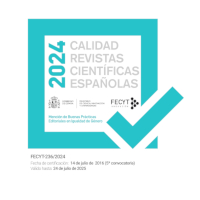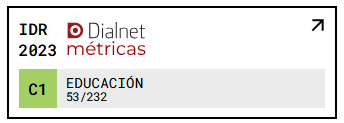La didáctica de la literatura inglesa con textos poéticos
DOI:
https://doi.org/10.18172/con.379Abstract
A student's first contact with English literature should be done taking into account the age, attitude, level of English and motivation of the learner. The selected text should provide a balance between the reader and the text thus assuring that the text will not be rejected. The texts should be coherent and progressively difficult. They should also use topics which are appropriate to the student. Primary Education English pupils possess different characteristics from those of university students. The teacher must also use graded literary texts so as to make both pupils and students respond in the desired manner. This is supposing that the teacher has a wide knowledge of literature and psychology and is thus able to choose the appropiate texts. Teachers use English literature for a variety of reasons these being improving linguistic competence, getting the students used to reading in English orto teach more about the country in question. There are also teachers who choose literary texts that their pupils will understand, the reason being that there are many books whose cultural references or language are too difficult for the pupils. The teachers take all these features into account in order to be able to provide the optimum learning conditions for the pupils. In providing these conditions the pupils are also helped to develop their literary competence so that they will appreciate the different styles, forms, conventions or symbols that can be found in the texts.Downloads
References
ALCARAZ, Enrique (1993). "La lingüística y la metodología didáctica de las lenguas extranjeras" en García Hoz 1993: 19-109.
BRUMFIT, Christopher y CARTER, Ronald. (1986). Literature and Language Teaching. Oxford: Oxford U. P.
CARTER, Ronald y LONG, Michael N. (1991). Teaching Literature. New York: Longman.
CERVERA, Juan. (1993). Literatura y lengua en la educación infantil. Bilbao: Ediciones Mensajero.
COLLIE, Joanne y SLATER, Stephen. (1994). Literature in the Language Classroom. A Resource Book of Ideas and Activities. Cambridge: Cambridge University Press.
DAKIN, Julian. (1993). Songs and Rhymes. Harlow: Longman.
ELLIS, Gail y BREWSTER, Jean. (1991 ). The Storytelling Handbook for Primary Teachers. New York: Penguin Books.
ESCUDERO MARTÍNEZ, Carmen. (1994). Didáctica de la literatura. Murcia: Ed. Compobell.
FRYE, N. (1973). La estructura inflexible de la obra literaria. Madrid: Taurus.
GARCÍA HOZ, Víctor. (1993). Enseñanza y aprendizaje de las lenguas modernas. Madrid: Rialp.
GARCÍA PADRINO, Jaime y MEDINA, Arturo. (1988). Didáctica de la lengua y la literatura. Madrid: Anaya.
LITTLEWOOD, N. (1986) "Literature in the School Foreign-Language Course." En Brumfit y Carter 1986: 1 77-1 84.
LONG, M. N. (1986). “A Feeling for Language: The Multiple Values of Teaching Literature.” En Brumfit y Carter 1986: 42-60.
LOTI, Bernard. (1986). A Course in English Language and Literature. London: Edward Arnold Publishers.
LOTI, Bernard.(1986). A Course in English Language and Literature Tutor's Book. London: Edward Arnold Publishers.
MARTOS, Eloy. (1988). Métodos y diseños de investigación en didáctica de la literatura. Madrid: MEC.
MUÑOZ, Miguel. (1992). La poesía y el cuento en la escuela. (Una metodología para el área de lenguaje en el ciclo medio de E.G.B.). Madrid: La conserjería de educación y cultura de la Comunidad de Madrid.
WRIGHT, Andrew. (1996). Cuenta cuentos. Madrid: Oxford University Press.
Downloads
Published
How to Cite
Issue
Section
License
The authors retain copyright of articles and authorize Contextos Educativos. Revista de Educación the first publication. They are free to share and redistribute the article without obtaining permission from the publisher as long as they give appropriate credit to the editor and the journal.
Self-archiving is allowed too. In fact, it is recommendable to deposit a PDF version of the paper in academic and/or institutional repositories.












